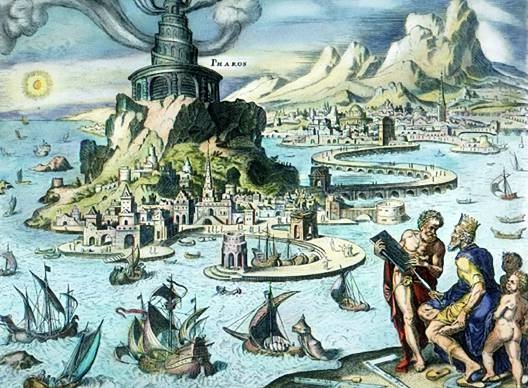- Construction and destruction
The lighthouse was completed in the 3rd century B.C., after having been initiated by Satrap (governor) Ptolemy I Soter, Egypt's first Macedonian ruler and a general of Alexander the Great. After Alexander died unexpectedly at age 32, Ptolemy Soter (Saviour, named so by the inhabitants of Rhodes) made himself king in 305 B.C. and ordered the construction of the Pharos shortly thereafter. The building was finished during the reign of his son, Ptolemy Philadelphos.
According to legend, Sostratus was forbidden by Ptolemy from putting his name on his work. But the architect left the following inscription on the base's walls nonetheless: "Sostratus, the son of Dexiphanes, the Cnidian, dedicated (or erected) this to the Saviour gods, on behalf of those who sail the seas"; the original Greek inscription "ΣΟΣΤΡΑΤΟΣ ΔΕΞΙΦΑΝΟΥ ΚΝΙΔΙΟΣ ΘΕΟΙΣ ΣΩΤΕΡΣΙΝ ΥΠΕΡ ΤΩΝ ΠΛΩΙΖΟΜΕΝΩΝ" literally means: "Sostratos of Dexiphanes [meaning: son of Dexiphanes] the Cnidian to Saviour Gods for the seafarers (or seafaring [ones])". These words were hidden under a layer of plaster, on top of which was chiseled another inscription honoring Ptolemy the king as builder of the Pharos. After centuries the plaster wore away, revealing the name of Sostratus.
The lighthouse was badly damaged in the earthquake of 956, then again in 1303 and 1323. The fullest description of it comes from the Arab traveler Abou Haggag Youssef Ibn Mohammed el-Andaloussi who visited the structure as a tourist in 1166. His description runs:
"The Pharos rises at the end of the island. The building is square, about 8.5m [just under 28 feet] each side. The sea surrounds the Pharos except on the east and south sides. This platform measures, along its sides, from the tip up to the foot of the Pharos walls, 6.5m [a little over 21 feet] in height. However, on the sea side, it is larger because of the construction and is steeply inclined like the side of a mountain. As the height of the platform increases towards the walls of the Pharos its width narrows until it arrives at the measurements above.
On this side it is strongly built, the stones being well shaped and laid along with a rougher finish than elsewhere on the building. This part of the building that I have just described is recent because on this side the ancient work needed to be replaced.
On the seaward south side, there is an ancient inscription which I cannot read; it is not a proper inscription because the forms of the letters are carried out in hard black stone. The combination of the sea and the air has worn away the background stone and the letters stand out in relief because of their harshness. The A measures a little over 54cm [slight more than 21 inches]. The top of the M stands out like a huge hole in a copper boiler. The other letters are generally of the same size. The doorway to the Pharos is high up. A ramp about 183m [600 feet] long used to lead up to it. This ramp rests on a series of curved arches; my companion got beneath one of the arches and stretched out his arms but he was not able to reach the sides. There are 16 of these arches, each gradually getting higher until the doorway is reached, the last one being especially high."
Constructed from large blocks of light-coloured stone, the tower was made up of three stages: a lower square section with a central core, a middle octagonal section, and, at the top, a circular section. At its apex was positioned a mirror which reflected sunlight during the day; a fire was lit at night. Extant Roman coins struck by the Alexandrian mint show that a statue of a triton was positioned on each of the building's four corners. A statue of Poseidon stood atop the tower during the Roman period.

The Pharos' walls were strengthened in order to withstand the pounding of the waves through the use of molten lead to hold its masonry together[citation needed], and possibly as a result the building survived the longest of the Seven Wonders—with the sole exception of the Great Pyramid of Giza. It was still standing when the Muslim traveller Ibn Jubayr visited the city in 1183. He said of it that: "Description of it falls short, the eyes fail to comprehend it, and words are inadequate, so vast is the spectacle." It appears that in his time, there was a church located on the top.The two earthquakes in 1303 and 1323 damaged the lighthouse to the extent that the Arab traveler Ibn Battuta reported no longer being able to enter the ruin. Even the stubby remnant disappeared in 1480, when the then-Sultan of Egypt, Qaitbay, built a medieval fort on the former location of the building using some of the fallen stone. The remnants of the Pharos that were incorporated into the walls of Fort Qaitbay are clearly visible due to their excessive size in comparison to surrounding masonry.
The fate of the Lighthouse of Alexandria from the Arab conquest until its collapse in the 14th century has been investigated by Doris Behrens-Abouseif in her article "The Islamic History of the Lighthouse of Alexandria" (in: Muqarnas XXIII [2006], pp. 1-14).


Niciun comentariu:
Trimiteți un comentariu